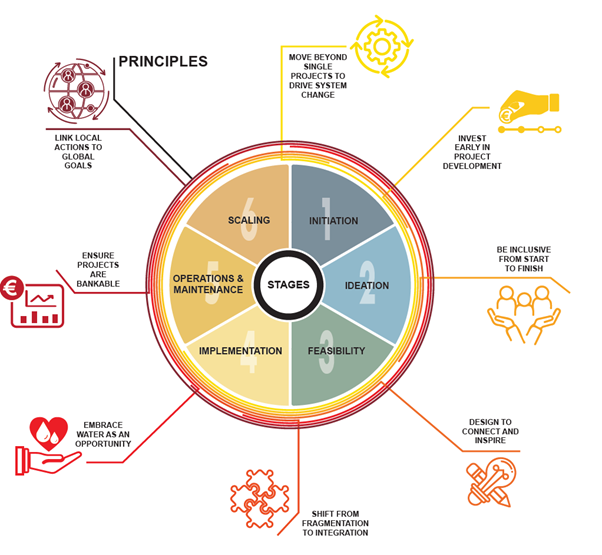Water as Leverage
Water is crucial to our lives; it shapes our environment, allows us to grow food, impacts our health, fosters biodiversity, and fuels our economies. Yet global developments such as climate change and rapid urbanisation put this precious resource under pressure. Cities around the world feel the effects of these challenges, yet they can also help solve these challenges by promoting urban water resilience. The Water as Leverage (WaL) approach promotes sustainable social, economic, and water climate resilience, serving as a catalyst for development. Deltares is an integral supporter of the programme, shaping the WaL academy and helping implementation on the ground.

Rethinking the approach for urban climate resilience
Cities are home to over half the world’s population, and this trend is only growing; estimates predict that demographic changes and migration will cause this figure to rise to nearly 70% by 2050. Climate change disproportionately affects these populations, putting them at the forefront of these (water-related) challenges.
Yet often efforts to tackle these challenges do not make optimal use of existing resources. There is a disconnect between policy and science, and between communities and financiers of urban structures. This hinders sustainable urban development, whilst simultaneously time aggravating water and climate risks instead of mitigating them.
The Water as Leverage approach
The Water as Leverage (WaL) approach offers an inclusive, integrated approach to tackle urban water-related challenges intensified by climate change and rapid urbanisation. A Dutch government initiative, it was launched in 2018.
Vulnerable communities are at the heart of the approach, which aims to improve their living environments. Stakeholders include local communities, financiers (such as banks), governments, designers, and more. By forming coalitions, enabling ownership and allowing for shifts in perception, stakeholders can jointly tackle urban water challenges. This allows for a focus on both short-term response and long-term urban resilience planning.
“Water as leverage is all about resilience. As citizens we will feel the impact of climate change. If we want to have liveable cities, we have to leverage water through engaging communities.”
- Meike van Ginneken, Special Envoy for International Water Affairs for the Kingdom of the Netherlands
The Water as Leverage programme
The WaL approach has been pioneered in cities around the world, including Semarang (Indonesia), Khulna (Bangladesh), Chennai (India), Cartagena (Colombia), Nakuru (Kenya), and the Wadden Sea region (Denmark, Germany, Netherlands). Although each instance is unique, they all share distinct water challenges, from rising sea levels to water contamination and flooding.
During the 2023 UN Water Conference, a global partnership announced a commitment to scale up WaL for worldwide urban climate resilience as part of the Water Action Agenda.
Deltares and Water as Leverage
Deltares supports WaL, including through the WaL Academy. The academy aims to establish WaL as a dynamic cultural approach that is adaptable to different contexts and future challenges. This includes developing guidance materials and offering learning opportunities based on the WaL framework to ensure its long-term resilience and applicability.
Deltares helped shape the Academy, developed the newly launched WaL Guidance, helped process framework learnings, and contributed to local training and capacity building (including in Bangkok, to see how WaL can inspire local water-related challenges).
Our experts have also helped implement WaL on the ground, forming part of the design teams and sharing systems knowledge as part of the development process. Their expertise has helped shape a range of WaL applications, including in Prayagraj, Chennai, and the Namami Clean Gange programme (India), and Semarang (Indonesia). Deltares also supports the WaL approach internationally, including by promoting it at innovation labs and at international events such as the World Water Forum.
The Water as Leverage Guidance
Published in 2025, the WaL Guidance has been designed to help foster transformative and inclusive project development. Drafted by Deltares and partners from One Architecture, the University of Groningen, and the Radboud University, the guidance builds on and shares experiences from WaL, Rebuild by Design, and other relevant initiatives. It features both case studies and practical advice for each stage of project development.
The Guidance is aimed at a range of stakeholders, including executive organisations, contractors, and change agents, offering them actionable perspectives. It comprises eight core principles, and a six-stage project development process that define the WaL approach.

The eight guiding principles
Eight guiding principles have been identified to foster urban water resilience. These principles are applied throughout the initiatives to drive transformative, inclusive change. The core principles are:
- Moving beyond single projects to drive system change. This allows for a holistic approach, rather than looking at projects individually and solving isolated problems. Such an approach allows for a system to become more resilient.
- Early investment in project development, an aspect that is often overlooked. Early investment allows for better initiatives and outcomes.
- An inclusive approach from start to finish, bringing together different organisations and individuals. Inclusive practices make projects more effective and sustainable.
- Designing to connect people and inspire action, allowing different sectors to come together. This fosters a comprehensive understanding of the water system and grants a clearer picture of the desirable results.
- Shifting from fragmentation to integration. By advocating a cross-sectoral approach, divides can be broken down and traditional siloed approaches left behind. Such a shift will connect sectors, levels, and disciplines.
- Embracing water as an opportunity, rather than a threat. Water is essential to our lives. By recognising its unique and universal role as a connector, we create opportunities for driving transformative change and harnessing solutions to ensure a more resilient future.
- Ensuring projects are bankable, meaning they have financial backing. This is key to successfully getting projects off the ground. Urban water projects can generate substantial value by reducing damages, enhancing liveability, and fostering economic activity.
- Linking local actions to global goals by recognising the multi-level dependencies and opportunities. Water cross-cuts all the UN’s Sustainable Development Goals, and Water governance spans multiple levels and sectors. Levering these links ensures optimal coordination across all levels.
The six stages
The guidance sets out a six-stage project development cycle to create transformative and inclusive urban water resilience projects. Each stage is designed to create lasting impact by fostering collaboration, securing financial backing, and ensuring projects address water resilience in a holistic manner. The stages are:
- Initiation: often resulting from an idea or an urgent need for new ways to tackle challenges. It involves a desire to start new ways of thinking and doing. Stakeholders collaborate to explore solutions and shape the initiative.
- Ideation: focuses on envisioning, designing, and formulating designs and project proposals.
- Feasibility: ensures continuity and viability, taking into account multiple perspectives (including economic, financial, technical, institutional, social, and environmental).
- Implementation: brings the project to life through construction, policy integration, and governance frameworks.
- Operations and maintenance: maintains the project and allows it to adapt to change; this is critical to ensuring the project remains functional and that it is further optimised over time.
Scaling: replicates projects, informs policies, and drives change. WaL projects are designed to create impact and drive change.


